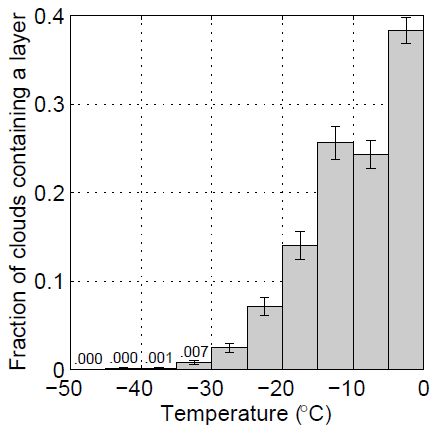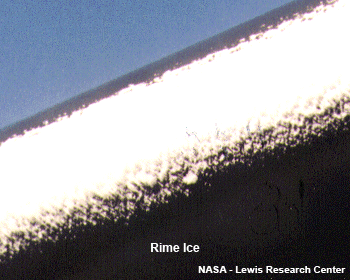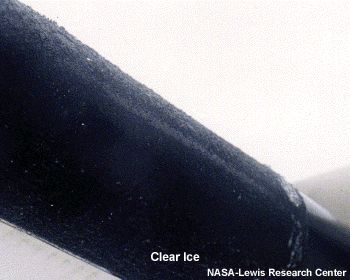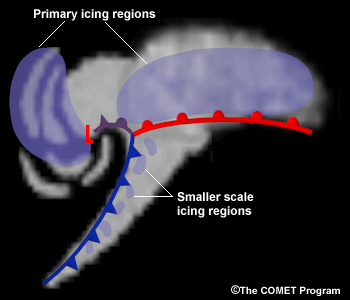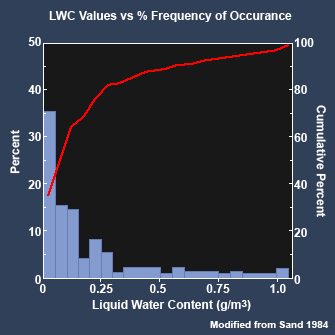Chapter II: What is icing
Table of Contents
- Intro
- Types of icing
- Severity of icing
Chapter II
Icing occurs when supercooled water freezes at impact with airplane´s surface. The freezing process is possible when there is supercooled water present in temperatures 0ºC ... -40ºC. In practice, there is no significant icing in clouds with the top temperature below -15ºC. Most common (and severe) cases of icing occurs in temperatures 0ºC ... -12ºC.
The amount or percentage of supercooled water within clouds is hard to measure. At mid-levels an estimate has been made combining radar and lidar measurements. This gives a rough picture of the occurrence of icing depending on temperature. The real values may be greater, because this method cannot take into account fronts and possible multiple icing layers. An aircraft measurement has shown that there might be as many as four separate icing layers on top of each other.
Fig. 2.1. Fraction of clouds (between 0 and 1) containing highly reflective layers (indication of liquid water) as a function of cloud temperature/K. Data collected by lidar (www.met.reading.ac.uk/).
Types of icing
There are two types of icing: rime formation and clear ice formation.
Rime ice (opaque, rough-skinned frozen particles) forms when droplets freeze rapidly upon striking the leading edge of wings and other exposed parts of the airframe. Rime occurs most often in temperatures between -1°C and -12°C, but rime icing also occurs with greater frequency than other ice types at temperatures colder than -15°C. Although rime is the most common type of icing, it is regarded as the least serious since it can be fought off (when foreseen) with deicing.
In a clear ice formation, only a small portion of the drop freezes immediately while the remaining unfrozen portion flows or smears over the aircraft surface, freezing gradually. Clear icing conditions exist more often in an environment with high liquid water contents and large droplets. It occurs mainly in temperatures between -0°C and -10°C. Clear icing is a more hazardous type of ice than rime.
Droplet size affects the collection of drops by the airframe. Small droplets tend to impact the airfoil near the plane's leading edge. Larger drops can impact farther back.
Because deicing and anti-icing devices are typically located near the forward edges of airfoils, ice that forms farther back on the airfoil is difficult to remove.
Fig. 2.2.a. Rime ice on a wing of an aeroplane (NASA - Lewis Research Center)
2.2.b. Clear ice on a wing of an aeroplane ((NASA - Lewis Research Center)
A type of clear icing that is particularly dangerous to flight operations is ice formed from supercooled large drops (SLD). This icing occurs in conditions of freezing rain or freezing drizzle.
SLD are water droplets persisting in subfreezing temperatures with a diameter greater than 40 microns. SLD include freezing drizzle (diameters 40…200 µm) and freezing rain (diameters greater than 200 µm).
Fig. 2.3. Relative droplet sizes in microns
Icing can also consist of mixed rime and clear ice (the most uncommon type).
The icing process is also related to the concentration of aerosols acting as condensation nuclei within the prevailing air mass. In a maritime air mass the air contains few aerosols, which means that large supercooled drops can form. Continental air contains a lot of aerosols, which is favorable for the formation of a great number of small droplets. On the other hand, continental air can be relatively clean as well, if it has been "washed" by precipitation.
SLD can be formed in two ways:
- warm layer process: ice melts and the water drops fall through a layer with below-zero temperatures, becoming supercooled
- collision-coalescence: droplet growth
In either case the presence of freezing precipitation at the surface is a good indicator of SLD aloft.
SLD formation processes:
Fig. 2.4. Animated SLD formation by the warm layer process
Collision-coalescence:
Fig. 2.5. SLD formation by the collision-coalescence process
Typical synoptic situations for icing
Most supercooled large drops with a diameter of over 100 μm develop via the collision-coalescence process. The typical environment for that process is a strong inversion above a stratiform cloud.
SLD and freezing drizzle in particular tend to occur when a saturated, gradually rising air mass coincides with relatively warm cloud tops (around -12 °C). Likely regions include:
- Ahead of warm fronts
- Behind low pressure centers, connected with occluded fronts
- Post-frontal upslopes
Fig.2.6. Typical locations of SLD in a mid-latitude cyclone
In mid-latitude areas the strongest icing occurs with drops larger than 200µm,
which usually occur in the wake of cold fronts.
In high latitudes drops between 100 and 200μm mostly occur ahead of warm fronts or warm occlusions, which dominate situations in high latitudes, where freezing rain is rarely observed elsewhere than ahead of warm fronts.
Severity of icing
The severity of icing depends on three factors:
- liquid water content (LWC)
- temperature
- droplet size
Of these, the most important one for the intensity of icing is LWC. It should be noted, however, that LWC can vary significantly both horizontally and vertically even in an apparently homogenous area.
Intensity classes listed by LWC (g/m³):
- light; 0,11 - 0,6
-
moderate; 0,61 - 1,2
-
severe; > 1,2
In short, in temperatures 0...-12°C icing is more severe the higher the LWC and the greater the droplet size.
Estimating the relevant factors for icing:
- LWC
Only a few of the operational NWP models include LWC as an output parameter.
Data of icing clouds has been collected with aircraft experiments in the mid-levels. In Figure 9 there is a compilation of over 1000 hours of data collected by the University of Wyoming's research aircraft. The vast majority of these cases have quite low LWC (less than 0.1 g/m3) with only about 17% of the cases having LWC greater than 0.3 g/m3. (MetEd)
Fig. 2.7. Frequency of occurrence of icing as a function of liquid water content /g/m3. The scale on the left: percent of cases, the scale on the right: cumulative percent of cases.
- Temperature
Temperature can be examined through soundings, infrared satellite images and NWP models fairly accurately.
- Droplet size
Cloud droplets have diameters less than 40 microns. In freezing drizzle the droplet size is 40 to 200 microns and in freezing rain greater than 200 microns (SLD). Droplet size is not predicted in the operational weather forecast models, but in some cases it can be estimated with radar observations.
